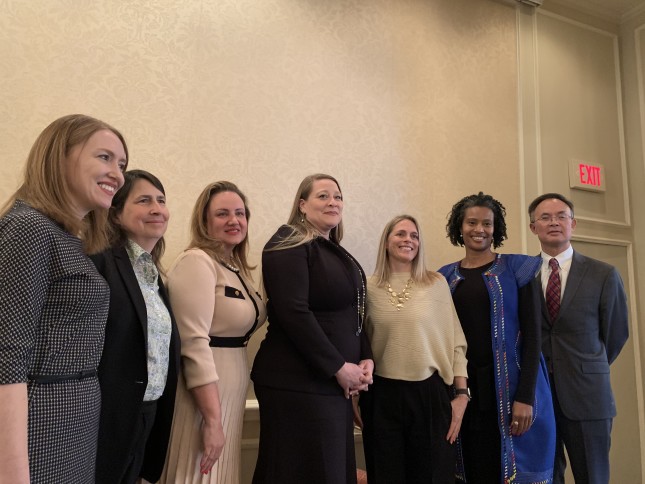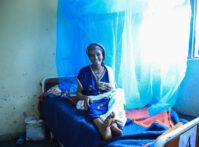-
Healthy Women, Healthy Economies: Translating Evidence to Impact
April 12, 2023 By Sophia DeLuca
“Women’s economic participation promotes economic growth and security. It’s good for the women involved. It’s good for the girls who dream of following in their footsteps,” said Ambassador Mark Green, President and CEO of the Wilson Center at a recent Women’s History Month private event in Washington, DC hosted by the Wilson Center and EMD Serono, the healthcare business of Merck KGaA, Darmstadt, Germany.
“Best of all, it’s good for society,” continued Ambassador Green. “It unleashes a wave of intellectual and economic might.”
The Healthy Women, Healthy Economies: Translating Evidence to Impact event focused on the importance of research to support and policies to uplift women’s health and economic engagement. “Policies focused on women’s health and safety and policies that recognize the necessity of caregiving of both children and the elderly must be in place for women to reach their full potential,” said Sarah Barnes, Project Director at the Wilson Center’s Maternal Health Initiative.
The evening focused on the 5 Pillars detailed in the Healthy Women, Healthy Economies Policy Toolkit: workplace health and safety; health awareness and access; sexual and reproductive health; gender-based violence (GBV); and work-life balance.
“At EMD Serono, we have a long history of understanding how critical women’s health is–not just for individual women–but for prosperity in the entire world,” said Terri Stewart, Senior Vice President and Head of Global Healthcare Government & Public Affairs at EMD Serono. The company is the private funder of the public-private partnership that created the Healthy Women, Healthy Economies initiative.
Health and Awareness: Maternal Health Disparities
Keynote speaker Loyce Pace, Assistant Secretary for Global Affairs at the Department of Health and Human Services (HHS), referred to recently released data from the National Center for Health Statistics in the United States that revealed that COVID-19 worsened maternal mortality in the U.S., especially for Black mothers.
“I was in London when the CDC report was issued and published and you could see how poorly we were doing with women’s health and specifically maternal mortality,” said Secretary Pace, who noted that while the UK and much of Europe experiences “two to three [maternal deaths] per 100,000 [live births], or even ten per 100,000, we see thirty. Seventy, when it comes to Black women in this country.”
U.S. racial disparities in maternal mortality can be readily glimpsed in Washington, D.C. In the city, Black women make up 90 percent of birth-related deaths, said researcher Dr. Guoyang Luo, Professor of Obstetrics and Gynecology at Howard University College of Medicine. Dr. Luo attributed this disparity to “high medical comorbidities among Black women, social determinants of health, racism and discrimination, and medical literacy and mistrust in the health system and in health providers.”
Inequalities in maternal health extend to mental health, as well. Black women are 1.6 times more likely than white women to develop postpartum depression, but significantly less likely to receive assistance, said Dr. Luo. As service providers seeking to reduce maternal death, “the research that we do is tackling the problem of disparities in maternal health by understanding what the causes might be and how we can do better.”
Dr. Luo observed that this research identified adherence of perinatal care as an ongoing challenge among underserved Black women in Washington, D.C. In response, he continued, “we designed and implemented a collaborative doula care model (CDCM) for early initiation of prenatal care among pregnant Black women with high-risk medical comorbidities.”
At HHS, identifying and reaching groups that have been historically overlooked by research or policy is essential. “I’ve come to really appreciate the importance of shining a light on communities and individuals who really have been left behind still,” said Pace. “Even with all of our investments, even with all of our commitments, we’re still not there yet.”
Work-Life Balance: Policy Supporting Women’s Participation in the Paid Labor Force
While the COVID-19 pandemic worsened maternal health outcomes and brought attention to existing disparities, it also shed light on historic barriers to women’s engagement in the formal economy. Rachel Vogelstein, Special Assistant to the President from the White House’s Gender Policy Council, outlined three issues that new Biden administration policy aims to address in order to increase women’s labor participation: care infrastructure, digital inclusion, and access to jobs in the green and blue economies.
“Just as roads and bridges help facilitate labor force participation, so too, we know, does the infrastructure that ensures that children are cared for, that elders are cared for, that those who are sick are cared for, while family members are at work,” said Vogelstein.
The focus on women is essential, noted researcher Dr. Jody Heymann, Founding Director of the WORLD Policy Analysis Center at the University of California, Los Angeles. “Women are not only more likely to be caregivers, they also devote more time to caregiving compared to male counterparts. Without policy protecting caregiving, inequality results,” she said.
Dr. Heymann also noted that “less than a quarter of the world’s countries provide any leave to care for a sick parent or a sick spouse. This has impacts for gender equality across the board, but it especially matters for the gaps [between women and men] in who becomes a manager.”
Gender-Based Violence and Workplace Health and Safety
Making policy that supports women’s participation in the formal economy doesn’t stop at care work. It also includes reproductive health and gender-based violence (GBV). Despite global movements like #MeToo raising global visibility of GBV (including sexual harassment), policies that protect women in the workplace still lag behind. Twenty-five percent of countries still have no protection against sexual harassment in the workplace, said Dr. Heymann.
“Gender-based violence, of which I am also a survivor, is experienced by more than one in three women globally at home, online, in the work environment, and while commuting. It restricts women from entering and participating in the economy, feeling safe at work, and advancing their careers,” said Katrina Fotovat, Senior Official in the Secretary’s Office of Global Women’s Issues at the United States Department of State. “Our collective work to achieve gender equality and advance health equity and equality increases women’s meaningful economic participation,” she said. “Lived experience will be at the center of all of this, and our policy also must be informed by data—and the data is clear.”
Continued research is at the core of changing policies and striving towards improved women’s health and gender equality in the paid workforce. “Through tonight’s discussion and the subsequent discussions that I hope will follow, we can not only shed light on issues, but blaze forward with new strategies and research ideas to tackle the barriers to women’s economic participation,” said Barnes.
“If the path forward was simple, I don’t think any of us would be having this discussion tonight,” said Stewart. “It’s why continued research is critically important on how to create a more ethical and healthy future for women around the world.”
Read More:
This event was held in part to inform the audience of the Healthy Women, Healthy Economies Research Prize which will highlight original research focused on women’s health. Applications may be submitted through June 3, 2023.
Sources: Sinay Maritime Data Solution, Asia-Pacific Economic Cooperation, National Center for Health Statistics.
Photo Credit: Speakers at the Healthy Women, Healthy Economy event, courtesy of The Wilson Center.
 A Publication of the Stimson Center.
A Publication of the Stimson Center.







